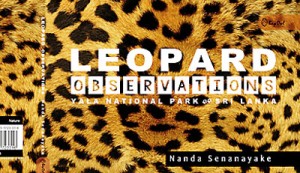There’s so much you’ll find out about our top predator
View(s):This fascinating book is a result of the author methodically collecting information on individual leopards of Yala National Park for nearly eight years. It is filled with new findings and is a “must read” for anyone who is interested in the ecology of our top predator.
Yala Block 1 is recognised world over as the best park to observe and study Leopards in the wild. Many books on Yala National Park depict the abundance of leopard sightings and for most visitors to the park, capturing a photograph of a leopard in the wild is an end in its self. However considering the elusive nature of these cats, few if any, have had the skill and the patience to individually identify them and systematically collect information on their behaviour. Nanda Senanayake, the author of this book had the interest and the determination to look beyond these photographs to reach a greater understanding of the remarkable lives of these clever predators.
Nanda, who is one of the most knowledgeable people on Sri Lankan wild life today, has been a regular visitor to Yala National Park for more than 50 years and had observed leopards with great interest. His identification of individual leopards and methodically keeping records of their behaviour commenced in December 2004. Having named each leopard he carefully documented the information gathered throughout the period based on direct observations as well as photographs and video recordings of leopards taken at Yala Block 1 by others.
This book contains a vast amount of statistical data and concise narratives on a number of important subjects that have never been published before on the Sri Lankan leopard. These include observations on courtship, litters, interaction between leopards, population density, longevity in the wild, impact caused due to over visitation and most importantly immediate measures to be taken to ensure the continuation of leopard sightings in Yala Block 1. Most of this information is presented with the help of many graphical and tabular presentations reflecting the hard work and long hours spent in the jungle by the author.
The author’s in-depth knowledge of leopard behaviour has enabled him to discuss hitherto unknown adaptations of these clever cats to overcome the challenges posed by their environment as a means of long-term survival. The author presents data to support a co-relation between the behaviour of female leopards in deliberately leaving their cubs by the roadside and the increase in visitations to the park. This unusual behaviour, he states, is in order to habituate the cubs with humans and vehicles. This book is full of such interesting information.
The photographs used in this book may not be the best in terms of quality, as they have been selected purely to support the data presented and highlight the points made by the author. In order to appreciate this book it is important that the reader should pay attention to all the graphical and tabular presentations. As these tables as graphs contain most of the information the author has kept the narratives to a minimum.
It is sincerely hoped that the relevant authorities will make use of the information that the author has been able to collect through his observations in determining conservation measures to ensure the long-term survival of the leopards in Sri Lanka.
Available exclusively from the author from November 27 until December 31, at a 10% discount (Rs. 2,250): 174/3 Inner Flower Rd., Colombo 3 (Tel: 0-777-718-045). Also available online from www.pererahussein.com
| Book facts
Leopard Observations, Yala National Park, Sri Lanka by Nanda Senanayake. Reviewed by Kithsiri Gunawardena.
|



